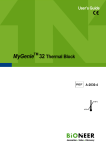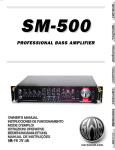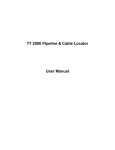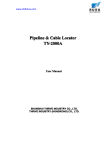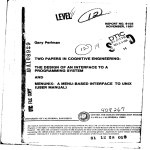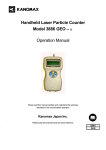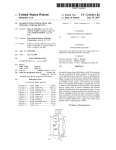Download PDF
Transcript
1 Manual Instruction 1.1 Symbols used in this manual This manual contains important instructions for safety and operation which must be understood and carefully followed during installation and maintenance of the equipment. In order to reduce the risk of electric shock and to be sure that the equipment is correctly installed and ready to operate, special safety symbols are used in the manual to highlight potential safety risks or useful information. The symbols are the following: DANGER! DANGER indicates a hazardous situation which, if not avoided, will result in death or serious injury. WARNING! WARNING indicates a hazardous situation which, if not avoided, could result in death or serious injury. CAUTION! CAUTION indicates a hazardous situation which, if not avoided, could result in minor or moderate injury. NOTICE NOTICE indicates a situation which, if not avoided, could result in property damage. Information Information provides tips that are valuable for the optimal installation and operation of your product. This manual and machine may also use the following electrical symbols and identification. Description as follows: Symbol Description Symbol Description — Continuous negative voltage pole Direct current -1- + Alternating current On (Supply) Earth (ground) TERMINAL Off (Supply) Protective conductor TERMINAL Caution, risk of electric shock Frame or chassis TERMINAL Caution, hot surface Continuous positive voltage pole Caution, risk of danger Caution, risk of electric shock. Energy storage timed discharge (time to be indicated adjacent to the symbol) Refer to the operating instructions 1.2 User group Please read this manual thoroughly. This manual contains information about EA3KLPV/EA4KLPV/ EA5KLPV single phase grid-connected inverter of transportation, installation, operation, maintenance and troubleshooting. 1.3 Validity This manual applies to EA3KLPV/EA4KLPV/ EA5KLPV grid-connected inverter. 2 Safety Instructions ¾ The inverter must be installed by a qualified electrician who is responsible for observing existing standards and regulations. ¾ Read and understand all the instructions contained in this manual and become familiar with the safety symbols in the relevant paragraphs before you install and operate the equipment. -2- ¾ The connection to the distribution grid must be done only after receiving approval from the distribution utility as required by national and state interconnection regulations, and can be done only by qualified personnel. ¾ Comply with all corresponding marks and symbols present on each device. During operation, make sure that all covers and doors are closed. DANGER! Unauthorized removal of the necessary protections, improper use, wrong installation or wrong operation may lead to serious damage to people and objects. Transport, handling, installation, start-up and maintenance must be performed by qualified and trained personnel. DANGER! After disconnecting the inverter from distribution grid, wait for 60 seconds for capacitors to discharge before servicing or touching any live part and electric connection. WARNING! The installation must be performed in full compliance with national and local standards and regulations. WARNING! When the photovoltaic array is exposed to light, it supplies a DC voltage to the PCE. To ensure a safe work environment, keep the whole surface of the photovoltaic panel covered with material opaque to solar radiation before connecting panel to equipment. WARNING! Make sure the DC input voltage does not exceed 520V, or it may damage this inverter permanently and cause other losses. -3- WARNING! Do not change the internal components of the inverter without permission. WARNING! If the equipment is used in a manner not specified by the manufacturer, the protection provided by the equipment may be impaired. 3 Product Description 3.1 Photovoltaic/PV grid-connected system PV grid-connected system consists of PV modules, grid-connected inverters, metering device and power distribution system (Figure 1). The solar energy is converted into DC current by PV modules and then feeding into the local power grid network by the grid-connected inverter which synchronizing the frequency, phase and pure sine waveform with the power network. PV modules Combiner box Inverter Metering Figure 1 PV grid-connected system -4- Power grid 3.2 Basic structure PV+ EMI DC/AC BOOST EMI L N PV- G Figure 2 Working principle of EA3KLPV This inverter is designed with boost+ inverter topology. The DC filter prevents the penetration of high-frequency line-bound interference. After the voltage equalization by the capacitor, the inverter converts the direct current from solar power system into alternating current with the same frequency and phase with the grid. The downstream LC filter has the purpose of equaling the current. Finally the current flows to the utility grid. In order to make maximum output power of photovoltaic array, it adopt advanced MPPT algorithm in the DC boost side. 3.3 Appearance, dimension and weight 3.3.1 Appearance LCD Button Information Inverter with 4 colors for customer choice. Respectively are: red, green, yellow, gray -5- PV Input RS485 Communication Terminal DC switch AC Output Figure 3 External Appearance of EA3KLPV/EA4KLPV/EA5KLPV Information Installation method as shown in the 5.5.1 of “Ⅰ”. RS485 Communication Terminal PV Input AC Output DC switch Figure 4 External Appearance of the special EA3KLPV Information Installation method as shown in the 5.5.1 of “Ⅱ”. Information The PV input has one channel of MPPT which consists of three pairs of terminals, so there can be max three PV strings connecting to the channel. -6- 3.3.2 Dimensions and weight 430 200 568 Figure 5 Dimensions of EA3KLPV/EA4KLPV/EA5KLPV The dimensions of the EA3KLPV/ EA4KLPV/ EA5KLPV are 430mm ×568mm ×200mm (W×H×D). The inverter weighs approximately 25kg. Please take this dimension and weight into consideration during shipping, moving and installation. 3.4 Technical data EA3KLPV Type EA4KLPV EA5KLPV Specification Input Nominal DC voltage 400VDC Operating voltage range 150V~500V Max PV input voltage 520 PV short-circuit current 20A 22A 22A Max DC current 18A 20A 20A Max DC power 3.3kw 4.3kw 5.3kw Peak DC short-circuit feedback current 159 A peak impulse (duration time 2ms) DC to case insulation voltage Basic insulation 1800Vdc/1min MPPT -7- Full-load MPPT voltage range 180~420VDC 210~420VDC 250~420VDC Number of MPP-Trackers 1 1 1 MPPT efficiency (static) >99% Output (AC) Working manner continuous Output phase number single phase and 3 line Nominal AC power 3kw Nominal AC voltage 230Vac Nominal AC current 4kw 5kw 13.5A 18A 22A Max allowable AC current 16A 20A 25A Nominal frequency 50Hz Distortion (THD) <3% (nominal power) Output voltage DC ponderance <0.5%(nominal output power) Power factor (cos phi) >0.99 Output current limit When overload or short circuit Inverter short-circuit current 130 A peak impulse (duration time 2ms) AC to case insulation voltage Basic insulation 1500Vdc/1min Efficiency Max efficiency 97.5% Euro efficiency 96.2% 96.3% 96.5% General Requirements Standby consumption 12w Night consumption 0W Grid connected method Direct connect(transformerless) Ingress protection IP65 Protection degree Type I RS485 to DC input insulation voltage Reinforce insulation 3000Vdc/1min Mean Time Between Failures(MTBF) 40,000 hours Working life 20 years Protection Reverse connect protection Input protection Short-circuit protection DC to ground insulation resistance detecting and >800kohm protection Output protection Short-circuit protection Grid monitoring Voltage monitoring,Frequency monitoring Input lower /over-voltage protection points 150V/530V Grid lower /over-voltage protection points TUV: DIN VDE 0126-1-1 184V/253V G59/2 X 200V/253V 200V/253V G83-1 207V/264V X X AS4777 205V/265V -8- Grid lower /over-frequency protection points TUV: DIN VDE 0126-1-1 50.2Hz/47.5Hz G59/2 X 52.0Hz/47.0Hz 52.0Hz/47.0Hz G83-1 50.5Hz/47.0Hz X X 52Hz/47.5Hz AS4777 Residual current monitoring Comply with DIN VDE 0126-1-1 Fault current monitoring Comply with DIN VDE 0126-1-1 Anti-islanding protection Comply with DIN VDE 0126-1-1 Standard Safety IEC 62109-1,IEC 62109-2 certification VDE/TUV/CE EMC EN61000-6-1,EN61000-1-2;Class B EMI EN61000-6-3,EN61000-1-4 Functional safety and anti-islanding DIN VDE0126-1-1/AS4777/G83-1/G59-2 Remark: Europe efficiency calculate : η Euro = 0.03η 5% + 0.06η10% + 0.13η 20% + 0.10η 30% + 0.48η 50% + 0.20η100% Others Items Specification Remarks Radiation noise CISPR22 Class A Conducted noise CISPR22 Class A AC short circuit protection Yes(current limited) Lightning resistant 1.2uS X 50uS 5kV DC/AC to ground ESD Protection Case to operational part 15kV System can work normally Noise <50dB 1m 5Hz 1G 30times at X・Y direction Vibration resistance 10Hz 1G 30times at X・Y direction JEC-5917 5Hz 0.5G 30times at Z direction 10Hz 0.5G 30times at Z direction Durable years Average temperature 25℃ 12H/day 20 years Environmental conditions Items Specification Operating temperature -20℃~ +50℃ Altitude 2000 m Relative humidity 4% ~ 100 % Noise level <50dB 1m Cooling Method Natural cooling * Above data just for reference. If there is a change, please refer to the machine. -9- Remarks 4 Installation 4.1 Safety DANGER! Danger to life due to fire or explosion! Despite careful construction, electrical devices can cause fires. • Do not mount the inverter on flammable construction materials. • Do not install the inverter in areas where highly flammable materials are stored. • Do not install inverters in areas with a risk of explosion. CAUTION! Risk of injury due to the heavy weight of the inverter. •Take the weight of the inverter into account for transport. • Select a suitable mounting location and mounting surface. • When mounting the rear panel, use fastening material suitable for the mounting surface. • Two people are needed to mount the inverter. CAUTION! Danger of burn injuries due to hot enclosure parts! Mount the inverter in such a way that it cannot be touched inadvertently. 4.2 Selecting the mounting location Consider the following points when selecting where to install: ¾ The protection level of this product is IP65, so it can be installed outdoors. ¾ Vertical installation. ¾ Do not install horizontally. ¾ Select a well-ventilated location sheltered from direct sun radiation. Choose a location that allows unobstructed airflow around the inverter. ¾ The operation will generate some noise (<50dB), so please install away from the people living space. ¾ Mount on a solid surface. Ensure the installation place does not wobble. - 10 - ¾ The machine should be installed in the reinforced concrete wall or metal wall that can bear the weight of the inverter. It should not be installed in the wood to keep from danger of fire. ¾ Height from ground level should be such as to ensure that the display and status LEDs are easy to read. ¾ Ensure the temperature range can keep in the range (-25°C — +50°C) ¾ Allow sufficient room around the inverter to enable easy installation and removal from the mounting surface. ¾ There must be sufficient clearance between the individual inverters so that the ¾ cooling air from the adjacent inverter is not drawn in. NOTICE Ambient temperature range shall be -20°C to +50°C. It will affect the power output when the temperature exceeds the limit. NOTICE Environment humidity must be in the range of 4% ~ 100%. 4.3 Wall mounting Included in the shipping package is a mounting kit with 6 screws and 6 wall plugs provided for mounting the metal bracket to a concrete wall. The screws should be mounted in the 6 holes present in the bracket (as Figure 5 shows). After the bracket is secured to the wall, hang the inverter on the bracket. As shown below. Bracket Rear panel Figure 6 Installation for cabinet - 11 - The inverter needs to be lifted up and then slid down over the hooks making sure that the connecting points in the bracket and in the back of the inverter engage properly. 5 Electrical Connection 5.1 General safety instruction DANGER! Improper operation during the wiring process can cause fatal injury to operator or unrecoverable damage to the inverter. Only qualified personnel can perform the wiring work. DANGER! Before you connect the inverter, disconnect the AC and DC sides from all power sources and secure them against being inadvertently switched back on. WARNING! Always respect the nominal ratings of voltage and current specified in section 4 (Technical Data) when designing your system. Please observe these considerations when designing the photovoltaic field: Maximum DC voltage input to each MPPT circuit: 520 V Maximum DC current input to each MPPT circuit: 18A for EA3KTLPV and 20A for EA4KLPV/ EA5KLPV WARNING! Check the national and local standard regulations to make sure that your electrical installation design is in compliance with them. NOTICE All cables must be firmly attached, undamaged, properly insulated and adequately dimensioned. - 12 - 5.2 The electrical connection diagram overview Inverter electrical connection includes PV side electrical connections, AC side electrical connections and communication cable electrical connection. No. Item Remarks DC circuit breaker Used as a protective device during electrical connection. User must equips this device according to the maximum input voltage and current. You must choose the external DC circuit breaker whose rated current is 40A and the max breaking capacity can reach more than 1kA. B PV arrays There are three pairs of input terminals in one MPPT channel for the inverter. The allowable maximum open-circuit voltage of PV arrays is 520V. And the allowable maximum short-circuit currents of the connected modules is 22A. C Remote PC A D AC circuit breaker E Grid User equips this device to monitor the state of the inverter. Used as a protective device during electrical connection. You must choose the external AC circuit breaker whose rated current is 40A and the max breaking capacity can reach more than 2kA. The PE cable should be connected reliably to the earth. Rated voltage of each phase of the utility grid is 230V. - 13 - 5.3 Cable requirements All cables for PV power system are equipped with water-proof direct plug-in connectors. You‘ll find these connectors in the package. For electrical connection in the PV system described above, the cross section of all cables used should not be smaller than the following requirements. Terminals AC Output Wire Size (mm) DC Input 1 DC Input 2 DC Input 3 L N + - + - + - EA3KLPV 11 11 10 10 10 10 10 10 EA4KLPV 10 10 10 10 10 10 10 10 EA5KLPV 10 10 10 10 10 10 10 10 Model AWG There are three channels of DC input which can connect three PV strings. The red is “+”, and the black is “-”. There is one channel of AC output, the red is L phase, the black is N phase,and the yellow-green is PE. NOTICE The grid impedance of the AC cable must not exceed 1 Ohm. Otherwise, the inverter will disconnect at full feed capacity due to excessive voltage at the feed-in point. 5.4 Connection of the PV generator (DC) 5.4.1 DC input wiring Positive terminal Negative terminal - 14 - 5.4.2 DC connection Step 1: Assemble DC cable to connector at the inverter side. See “5.4.1 DC Input Wiring”. Step 2: Disconnect DC and AC circuit breakers. Step 3: Check connection cable of one PV array string for correct polarity and that the maximum input open circuit voltage does not exceed 520V. Step 4: Measure DC voltage between positive terminal of the PV string and Earth and DC voltage between negative terminal of the PV string and Earth. If the two voltages are constant and not zero, there is an insulation failure somewhere in this PV string. - 15 - Step 5: Plug DC positive and negative connector into corresponding terminals. If it makes a click sound, it means DC connector has attached to terminals. Step 6: Link the rest of the two photovoltaic module strings in the same manner. NOTICE To create the sealing of the inverter, all the DC inputs that are not required have to be closed as follows: – Insert the sealing plugs provided into the DC plug connectors that are not required. Do not insert the sealing plus into the DC inputs on the inverter. – Insert the DC plug connectors with sealing plugs into the corresponding DC inputs on the inverter. 5.5 Connecting inverter to AC grid 5.5.1 AC output wiring NOTICE As the series of products, in the 3KWpower section, there are two kinds of AC output terminals, So,in the installation of EA3KLPV machine, please install personnel to select the corresponding installation method Ⅰ: Do not plug in AC output terminal installation method NOTICE The following installation method applicable to the series, with the exception of the special EA3KLPV; External Appearance as shown in Figure 3 - 16 - Step 1: Unscrew AC output cover at the downside of the machine. Step 2: Insert stripped AC cables of appropriate size into the cable glands. Fix the phase cables into corresponding terminals with screwdriver according to marks. Fix ground cable into the ground terminal. - 17 - Step 3: Screw the AC output cover. Step 4: Tighten the cable gland in clockwise direction. Ⅱ: Pluggable AC output terminal installation method NOTICE The following installation method is only applicable to the series of special EA3KLPV ,External Appearance as shown in Figure 4. - 18 - Step 1: Put the wires through Screw Cap, Adapter Body of the AC female connector. Keep the wire L, N, PE corresponding to 1、3、 of the AC male connector on the inverter correctly. 1 3 L N PE Wire red Wire black Wire yellow&green Attention! Please ensure the corresponding relationship between polarity the core cable and the holes of the terminal is the correct Step 2: Screw these components tightly after connecting the wires. Step 3: Finally, connect AC female terminal to AC male terminal on inverter ,tighten the cable and then screw them tightly together. - 19 - DANGER! Danger to life due to fire or explosion! Despite careful construction, electrical devices can cause fires. • Do not pull out the connector, when grid-connected inverter is working, so as to avoid electric shock hazard. • Do not immediately contact pin, when grid-connected inverter after disconnection, there may be residual electricity, 5.5.2 AC connection Step 1: Assembling AC cables to connector supplied. See “5.5.1 AC Output Wring”. Step 2: Make sure that AC and DC circuit breaker are disconnected. Step 3: Connect L, N to AC circuit breaker. − Plug AC connector to corresponding AC terminals. − Screw AC cables to AC circuit breaker. Step 4: Connect PE to the ground. Step 5: Connect AC circuit breaker to utility grid. Step 6: Make sure that all AC cables are firmly installed. NOTICE Assignment of AC cables should be paid attention to, especially “PE/GND” wire. 5.6 Connecting communication cable 5.6.1 Assembling the RS485 plug connector Step 1: Make the communication cable through the waterproof ring, and then connect the cables to the terminal. - 20 - 1 Blank 2 B 3 A 4 GND 2. Fasten the waterproof ring and case. 3. Finally, match the finished terminal to the RS485 communication port on the inverter’s case,then it is ready for communication. 5.6.2 Monitor system connection The inverter provides RS485 interface to communicate with remote PC. User can monitor the state of the inverter and observe current running information and history record via this interface. Below is the method to install the monitoring system. 6 Switch on and off 6.1 Switch on 1. Finish the installation of the PV array, AC grid and the inverter according to the introduction before. 2. Before switch on, checking whether AC voltage and DC voltage can meet the requirement of the inverter 3. Switch on the DC breaker at first. 4. Then switch on the AC breaker. 5. When the environment conditions allow the inverter to work, the inverter will automatically start up and connect the grid to generate power. 6. After the inverter works normally on grid, it can be left working itself without human control. It can shut down when fault occurs and it can start automatically after the fault is gone. - 21 - 6.2 Switch off 1. When solar power was not enough to generate the power, the inverter will shut down automatically. 2. If you need to shut down yourself, you can operate the inverter through the front panel screen. 3. The process of emergency shutdown. If you need shut down the inverter in emergency, first turn off the AC breaker, then turn off the DC breaker, otherwise it may lead to the damage of the DC breaker and danger to people. If any damage or loss occurs due to not following this requirement, EAST POWER will not follow the warranty. 7 Troubleshooting 7.1 Troubleshooting of the LED indicator Type of fault Troubleshooting LED indicators and LCD 1. Disconnect AC circuit breaker. cannot be lit 2. Disconnect DC circuit breaker. 3. Check the polarity of DC input. “RUN” indicator goes out 1. Disconnect AC circuit breaker. 2. Disconnect DC circuit breaker. 3. Check the correctness of electrical connection of inverter. 4. Check whether the voltage of DC input exceeds start-up voltage of inverter. 5. If all above conditions are OK, please contact East. “Fault” indicator is lit red. 1. There is a fault which is not removed yet. 2. Perform troubleshooting according to fault type in LCD screen. See “7.2 Troubleshooting of Faults in LCD Screen”. 3. If it can’t be solved, please contact East. - 22 - 7.2 Troubleshooting of faults in LCD screen Type of fault Explanation Troubleshooting PV OV Overvoltage in PV input 1. Disconnect AC circuit breaker. 2. Disconnect DC circuit breaker. 3. Check the voltage of PV side. 4. Restart the inverter until the DC voltage returns to allowable range. BUS OVER/ RPH.OV Overvoltage of the bus/ Overvoltage of grid voltage RPH.UV Under voltage of the grid 1. Disconnect AC circuit breaker. 2. Disconnect DC circuit breaker. 3. Check the voltage of grid side. 4. If local grid condition exceeds AC requirements of inverter, reset the protecting parameters. See “8.2.4 PARA. SET”. And if local grid voltage exceeds the upper limit value of “Vgrid-max”, or if local grid voltage is under the lower limit value of “Vgrid-min”, please contact your local electricity company to adjust the grid voltage. 5. If the fault still exists, please contact East. RPH.OFR Over-frequency in the grid RPH.UFR Under-frequency in the grid 1. Disconnect AC circuit breaker. 2. Disconnect DC circuit breaker. 3. Check the frequency of grid side. 4. If local grid condition exceeds AC demands of inverter, reset the protective parameters. See “8.2.4 PARA. SET”. And if local grid frequency exceeds the upper limit value of “Fgrid-max”, or if local grid frequency is under the lower limit value of “Fgrid-min”, please contact your local electricity company to adjust the grid frequency. 5. Close DC circuit breaker. 6. Close AC circuit breaker. 7. If the fault can’t be solved, please contact East. - 23 - BOOST OT R MO. OT/ Over- temperature in Boost module Over-temperature in the inverter module 1. Check whether the installation place is OK. 2. Check whether AC output power exceeds rated power too much. 3. Check the state of the fans. 4. Check whether there is some foreign body blocking the air inlet and outlet. Clean air grills of air vent. RPH.OC Over-current in the grid side Check whether AC output power exceeds rated power too much. RPH.OL Overload in the grid side Check whether there is too much load in the output grid. NO GRID /ISOLATED The grid is not normal. 1. Check whether AC circuit breaker is off. 2. Check whether AC cables are all firmly connected. 3. Check whether grid is cut off. 4. If all conditions are OK and this malfunction still occurs in the LCD screen, please contact East. MO.FAULT There is a fault in the module If this malfunction occurs, the reasons are very of the inverter. complicated. 1. Disconnect AC circuit breaker. 2. Disconnect DC circuit breaker. 3. Check the temperature of heat sink. If its temperature exceeds 80℃, restart the inverter until it recovers to environment temperature. 5. Close DC circuit breaker. 6. Close AC circuit breaker. 7. If this malfunction happens again, please contact us. LEAKAGE C. The leakage current is abnormal. PV NO EARTH The insulation between the PV and the Earth is abnormal. RELAY FAULT The state of the relay in the inverter is abnormal. If the LCD shows these faults, there may be something damaged in the inverter or the solar modules. Then you’d better not touch any component of the inverter, shutdown the circuit-breaker or the disconnector immediately and then contact us. - 24 - 8 Operation Instructions 8.1 Front panel introduction The front panel consists of LCD, state indicator and the button, by which we can set the parameters and observe the operating status. LCD display Button Indicator Figure 9 LCD and Interface 8.2 Operation of LCD 8.2.1 RUN INFO. 1. Automatic screen saver interface, it displays the main running parameter including input voltage, input current, input power, grid voltage, grid current, grid power and frequency. After 5 minutes, if there is no operation, the LCD interface will automatically go into the default interface. It contains running status, generation power, the present time and date and also the fault information. 2.Press “ENTER” into the control main menu 3. Select “RUN INFO”, press “ENTER” , you can check the overall running information - 25 - 4. It first shows the PV input parameters 5. Press , it displays the actual parameters of AC output 8.2.2 HISTORY 1. Enter the default main menu interface; 2.Press “ENTER”into the “control main menu; 3.Select “HISTORY”; 4. Press “ENTER”into the “History” menu 5. Fault history including present fault information and history fault information。 6. The exact fault as below: DC over voltage, AC low voltage, frequency abnormal, island effect, temperature abnormal, DSP abnormal, communication abnormal and so on.。 7. Press to next page to see the information. 8. Press “ENTER”,showing the interface to clear history information . - 26 - 9. Select OK ,press “ENTER”, it will shows the input code interface; 10. Input the correct password ,the history information will be cleared ,please confirm it before the operation。 8.2.3 POWER ON/OFF 1. Enter the default main menu interface; 2. Press “ENTER”into the “control main menu”; 3.Select “POWER ON/OFF”; 4. Press “ENTER” into the power off interface; 5. Press “ENTER”to power off. - 27 - NOTICE In normal case, when the external condition is OK, the machine will start by itself. 8.2.4 PARA. SET 1. Enter the default main menu interface; 2. Press“ENTER”into the “control main menu”; 3. Select “PARA. SET”; 4. Press “ENTER”; 5. The default password is month+date+time, six number, eg: month and date is 2011-06-07, time is 15:23:11, so the code is 060715; 6. press“ENTER” 7. Enter the parameter setting interface, you can set the language, time, communication mode, protect parameter, code and so on; 8. Select “language”, press “ENTER”into the language setting interface. There are five kinds of language, you can select the relative language, use the“ ”to find the language you need and press “ENTER” to confirm. 9. Select “time set”, press “enter” into the time setting interface, you can set the date and time; - 28 - 10. Select “communication set”, press “ENTER”, you can set the communication address and the baut rate; 11. Select “Protection set”, press “ENTER” into the protection setting interface ,you can set the on-grid voltage and the protect frequency; 12. Select “Code set”, press “ENTER “into the code setting interface, you can set the password in order to strengthen the safety of the system; 13. Select “return initial set”, press “ENTER” into the initializing interface ,it can initialize the language, time, date, communication ,protect parameter and so on. All the record and fault information will be cleared and return to the parameter set interface ,so please think carefully to use the function of returning to the factory value; 14. Press “ENTER” to select the data ,use the to add or delete the value, after the set of the last value, press “enter” to confirm; 15. When the value of the generation power on the LCD is not the same with the outside metering device ,the interface will change the generation value ; Notice that when you select +,use can change the +/-; 16. Generation power compensation=metering device value-generation power value on the LCD; NOTICE The communication parameter is the most important parameter in the inverters’ communication and the communication between the inverter and the external monitor device. - 29 - 8.2.5 PRODUCT INFO. 1. Enter the default main menu interface; 2. Press “ENTER” into the control main menu. 3. Select “product information”; 4. Press“ENTER” 5. The interface will display the company’s name, the product’s type and software version. 9 Appendix 9.1 Packaging list Check the packaging list for completeness and for any visible external damage. Contact your dealer if anything is damaged or missing. No item quantity/unit 1 PV Grid-connected inverter 1 set 2 User’s manual 1 pcs 3 Product warranty card 1 pcs 4 screws 6 pcs 5 PV input terminal 1 set 6 AC output terminal 1 set Table1 Packaging list - 30 - remarks 9.2 Exclusion of liability The content of these documents is periodically checked and revised, when necessary, please call us or check our website for the latest information. However discrepancies cannot be excluded. No guarantee is made for the completeness of these documents. Please contact our company or distributors to get the latest version. Guarantee or liability claims for damages of any kind are excluded if they are caused by one or more of the following: z Improper or inappropriate use or install of the product z Installing or operating the product in an unintended environment z Installing or operating the product when ignoring relevant safety regulations in the deployment location z Ignoring safety warnings and instructions contained in all documents relevant to the product z Installing or operating the product under incorrect safety or protection conditions z Altering the product or supplied software without authority z The product malfunctions due to operating attached or neighboring devices beyond allowed limit values. z In case of unforeseen calamity or force majeure. - 31 -


































